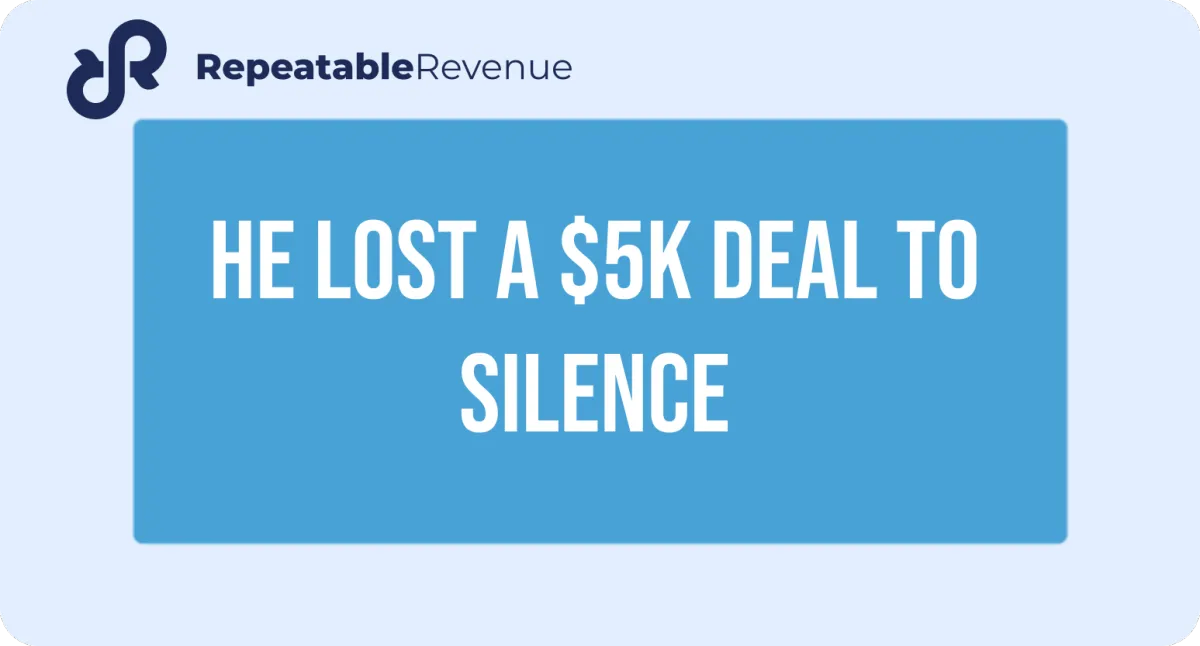
He Lost a $5K Deal to Silence
An MSP owner called me last week, frustrated as hell.
His sales rep had just invested 20+ hours into what looked like a sure thing—discovery went great, the assessment was thorough, the proposal meeting seemed positive.
Then... radio silence.
Not a "no thanks." Not a "we need more time." Just complete ghosting after weeks of work.
"This keeps happening," he told me. "How do we stop wasting time on deals that go nowhere?"
Here's the brutal truth: Most B2B sellers can't tell the difference between a prospect who's genuinely working through their buying process and one who's already decided against you but doesn't have the guts to say it.
And that uncertainty? It's killing your pipeline.
The Limbo Tax
Think about what happens when you can't read the situation:
You keep following up on dead deals (annoying them, wasting your time)
You miss real opportunities while chasing ghosts
Your pipeline looks healthier than it actually is
You can't accurately forecast revenue
Worse, your team starts doubting their abilities when the real problem is they're playing a guessing game.
The good news? You don't have to guess anymore.
These are 3 battle-tested ways to lead more prospects to an actual decision, and minimize the time you’re wasting chasing deals that’ll never close.
1. Learn What Their Buying Process Is Early (When They're Still Honest)
Early in discovery, prospects are more open. They haven't put up their defenses yet. That's your window to understand what's really going to happen.
But here's where most sellers blow it—they waste time in discovery asking surface-level questions. Or worse, asking the notoriously unreliable "Who's the decision maker?" question outright. (They know you're trying to hijack their buying process—so they won't tell you even if other people are involved.)
Instead, try figuring out what to expect when it’s time to make a decision by asking questions like these:
"What makes this a now conversation—not six months ago, not six months from now?"
This reveals their urgency level and whether there's real momentum or they're just kicking tires.
"How do you typically make these types of decisions when it comes to important partners? Do you have a leadership team or board that chimes in along the way?"
Notice I said "typically"—you're asking about their process, not putting them on the spot. Give them space to share the general process without feeling like you’re going to put the brakes on the process until everyone you need is in the room.
"When evaluating your IT services—response times, general support levels, etc.—who do you usually include in the conversation?"
Again, "usually" keeps it conversational. You're learning about their team dynamics without being pushy.
The answers to strategic questions like these in discovery become your roadmap. When they go quiet later, you'll have a better sense of whether they're genuinely conferring with their CFO or if they've ghosted you.
2. Use the 1-10 Scale (But Do It Right)
At your proposal meeting, after you've presented everything and they tell you there are some other steps they need to go through on their end, try this:
"Completely understand. Its a big decision and I’m not here to rush you. If you don’t mind me asking, on a scale of 1 to 10—with 1 being 'not in a million years' and 10 being 'where do I sign?'—where would you say you are now with us being a perfect partner for you?"
Or this:
"...on a scale of 1 to 10—with 1 being 'doesn't solve our problem at all' and 10 being 'this fixes everything'—how are you feeling at this moment about what we've presented?"
Typically you’ll get a 6, 7, or 8.
Here's where the magic happens:
"So, what would need to change to make this a 10?"
Now they're telling you the real objections. Not the polite brush-offs, but the actual concerns keeping them from moving forward.
One MSP I work with started using this approach and discovered that most of their "timing isn't right" objections were actually budget concerns in disguise. Once they knew the real issue, they could address it.
3. Give Them Permission to Say No
This one feels counterintuitive, but stick with me.
If someone's already decided against you, the deal is dead whether you acknowledge it or not. But if you keep chasing, you're just burning time and credibility.
So make it easy for them to tell you the truth:
"Hey John, I know you're busy and the last thing I want is to be another annoying vendor in your inbox. If you've decided to go a different direction, I completely understand. Could you just let me know so I can close out my file and stop bugging you?"
Notice what this does:
Positions you as respectful of their time
Takes the pressure off them
Actually increases the chance they'll re-engage if they ARE still interested
What NOT to do: Those passive-aggressive "breakup emails" that sound bitter or entitled. You're not entitled to an answer—you earn it by being professional.
Your Next Deal Doesn't Have to Disappear
Here's what changes when you implement these three approaches:
You'll have a better sense of whether you're in a real buying process or not. You'll uncover and address the actual objections (not the polite excuses). And you'll stop wasting weeks chasing deals that were dead on arrival.
So, pick ONE of these strategies and use it on your next prospect interaction:
In discovery, ask about their typical decision-making process
At your next proposal, use the 1-10 scale question
With a stalled deal, send the "permission to say no" message
You don't need to revolutionize your entire sales process. Just stop playing the guessing game.
Because every hour you spend chasing ghosts is an hour you could've spent closing real business.
Adios,
Ray
P.S. – What's your biggest frustration with stalled deals? Hit reply and let me know. I read every response and your challenge might become next week's newsletter topic.
